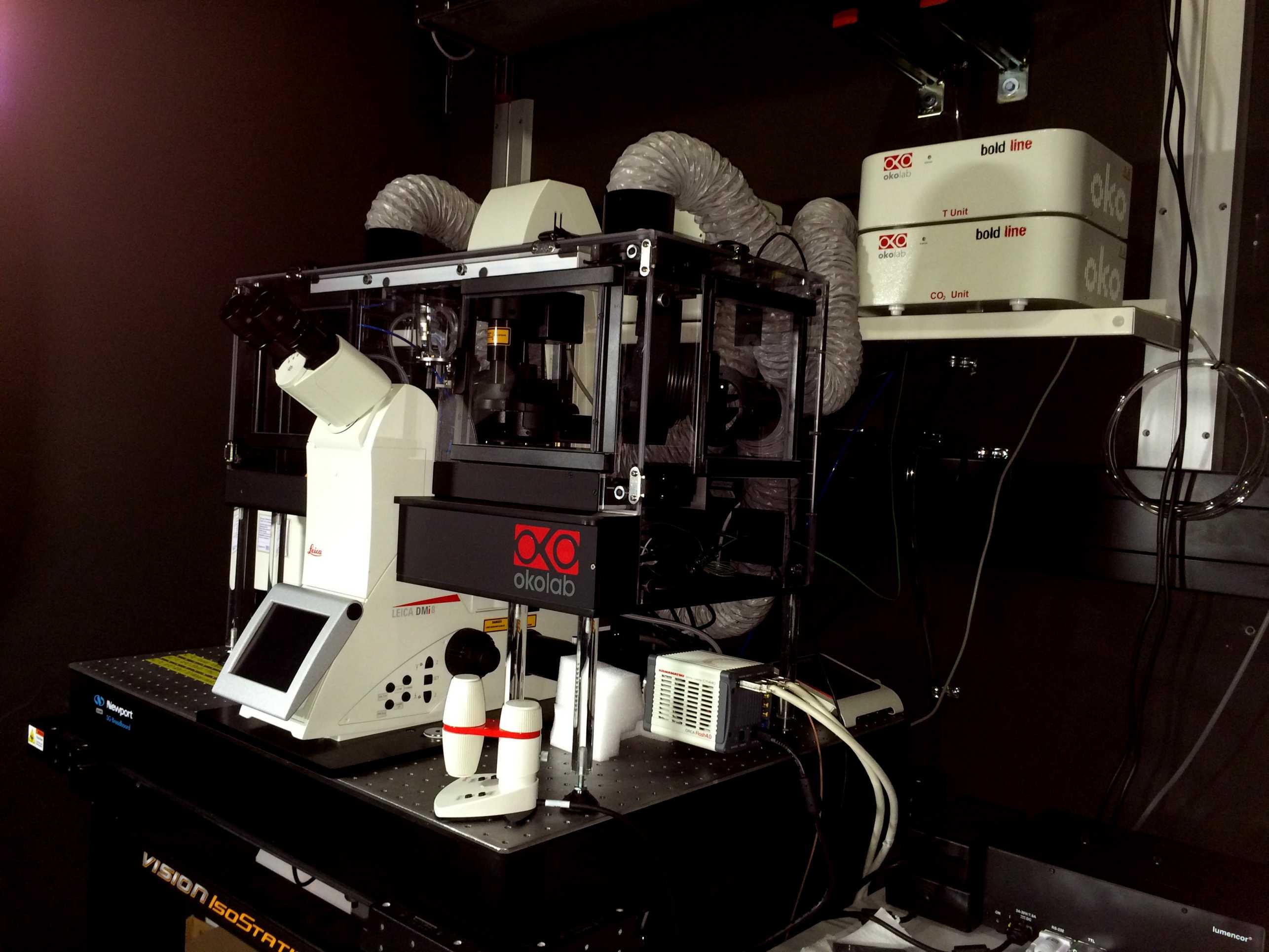Leica SP8-AOBS
Brief description
This confocal Leica TCS SP8 microscope consists of an inverted stand equipped with a live cell incubation chamber (Okolab) as well as a resonant scanner (8kHz) for fast confocal live cell applications. In addition the system is equipped with a sCMOS camera (Hamamatsu Orca Flash 4.0) and can be used as a conventional fluorescence widefield microscope.
Technical details
Microscope:
Leica DMI8-CS with blue/green/red epifluorescence illumination for visual observation through the eyepiece; Condensor (Air 0.55NA)
Illumination:
- Laser unit for confocal acquisition (AOBS system): 458, 477, 488, 496, 514 nm (Argon laser), 405 nm, 561 nm, 633 nm
- Lumencor SpectraX for widefield acquisition (camera) and visual inspection
Objectives:
- 10x 0.3NA HC PL Fluotar Ph1
- 20x 0.75NA HC PLAN APO CS2
- 25x 0.95 W HC Fluotar VISIR 0.17 (optimal for IR CARS imaging)
- 40x 1.1NA W HC PL APO motCORR CS2
- 63x 1.4NA Oil HC PL APO CS2
Detectors:
- 2 HyD
- 2 PMT
- 1 PMT Trans
Software:
- Leica LAS X SP8 Version 1.0 (offline Leica LAS AF version 3.3 at Image processing station 2 in HPI F10.1)
- additional licences for Live data mode, Dye separation, 3D rendering and FRAP
- Huygens Deconvolution
Key features:
- Stage: Motorized Märzhäusser stage with Leica Galvo stage
- Scanner: Tandem Scanner with Galvanometric scanning unit and Resonant scanning unit (8 kHz)
- Incubation: Okolab box type temperatur incubation with CO2 (Fitting Ibidi, LabTeks and 35 mm dishes, Mikrotiteplates)
Fluorescence settings:
- For internal detection: Leica patented flexible filterfree detection within whole VIS range, spectral detection possible
- Fluorescence filter cubes for DAPI, FITC, TRITC for visual inspection
SRS and CARS Microscopy:
Our Leica SP8 confocal microscope is fully equipped for Coherent Raman Scattering Microscopy (CRS) including:
- CARS, Coherent Anti-Stokes Raman Scattering and
- SRS, Stimulated Raman Scattering, Germany)
CARS and SRS signals are excited using two temporally and spatially overlapped pulse trains from a PicoEmerald S optical parametric oscillator (APE, Berlin, Germany), Pump and Stokes beam, such that:
fp-fs=fvib
In other words, the frequency difference between the Pump and the Stokes laser beams is tuned to match exactly the vibrational frequency of a molecular bond, such that the combined action of both beams causes the resonant excitation of the vibrational mode.
The Stokes beam wavelength is fixed at 1031.25 nm, and the Pump beam is tunable: 750–940 nm, allowing the excitation of vibrations in the range of 941 cm-1 to 3636 cm-1.
Both pulses are ~2 picoseconds in duration, providing a ~12 cm-1 spectral resolution of the total system. For SRS microscopy, the Stokes beam intensity is modulated at 20 MHz using an Electro-Optical Modulator (EOM). To acquire SRS signals, the Pump beam intensity is recorded in the forward direction using a silicon photodiode, and demodulated using a Lock-In amplifier (Zürich Instruments, Zürich, Switzerland). CARS microscopy does not require intensity modulation, and signals are detected on photomultiplier tubes in both the transmitted and the epi-detected directions in NDD detectors. The following filters are used:
CARS 2000S for wavenumbers above 2000 cm-1: 600–730 nm
CARS 1200S
SHG: 380–550 nm
In front of SRS detector: 680–1010 nm
Second harmonic generation (SHG) / two-photon excited fluorescence signals can be recorded simultaneously with the CARS signals. Forward SRS and Epi-CARS/SHG detection are possible simultaneously.
